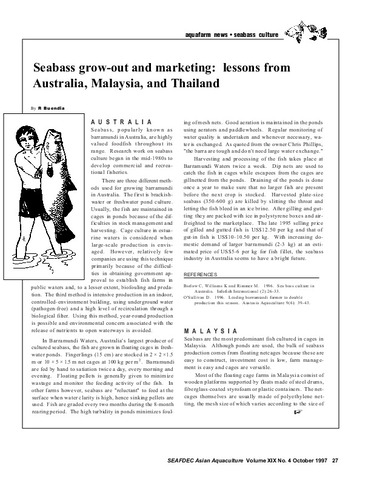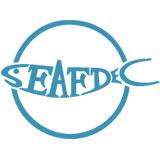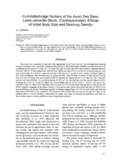| dc.contributor.author | Fermin, Armando C. | |
| dc.contributor.author | Bolivar, Ma. Edna C. | |
| dc.contributor.author | Gaitan, Albert | |
| dc.date.accessioned | 2013-04-08T05:44:47Z | |
| dc.date.available | 2013-04-08T05:44:47Z | |
| dc.date.issued | 1996 | |
| dc.identifier.citation | Fermin, A. C., Bolivar, M. E. C., & Gaitan, A. (1996). Nursery rearing of the Asian sea bass, Lates calcarifer, fry in illuminated floating net cages with different feeding regimes and stocking densities. Aquatic Living Resources, 9(01), 43–49. | en |
| dc.identifier.issn | 0990-7440 | |
| dc.identifier.uri | http://hdl.handle.net/10862/1557 | |
| dc.description.abstract | Successful rearing of hatchery-reared sea bass, Lates calcarifer, fry in illuminated floating cages was demonstrated in a 42-day experiment. Three feeding regimes, i.e. natural zooplankton (NZ) + minced fish flesh (MFF), NZ alone, or MFF alone and two stocking densities (600 and 1 200 individuals m2) were tested in a 3 × 2 factorial experiment. Fish reared in unlit cages and fed MFF alone during daytime served as the control. Results showed that no interaction existed between stocking density and feeding regime and that the two stocking densities used did not influence fish growth in terms of mean final body size. In general, sea bass reared in lit cages (NZ + MFF and NZ) grew and survived better than the control fish (MFF). However, fish reared under NZ + MFF feeding regime had the highest final mean total length (TL, 42.1 mm) and body weight (BW, 1 311.8 mg) followed by fish reared under NZ feeding regime (mean TL = 26 mm, BW = 415 mg). Fish in the unlit control cages exhibited the poorest growth (final mean TL and BW: 26 mm and 277.6 mg BW). Furthermore, specific growth rates (range: 5.7–8.5% day−1) of fish in lit cages were significantly better than those of fish in the unlit control cages (mean: 3% day−1). Percentage survival (38%) of fish stocked at 600 m−2 density and fed NZ was not significantly different from fish in the NZ + MFF feeding regime. However, increasing the density to 1 200 ind. m−2 tended to significantly decrease percentage survival (20%) of fish with NZ feeding. Fish reared in the unlit control cages had the poorest survival of 13–14%. The high percentage composition by number (CN, 88%) of copepods in the stomachs of sea bass fry fed on NZ alone and the equally high percentage feeding incidence (94%) indicated that fish fed sufficiently on natural zooplankton. Supplemental feed using minced fish flesh contributed about 43–59% of the fish diet in addition to natural zooplankton. | en |
| dc.language.iso | en | en |
| dc.publisher | Cambridge University Press | en |
| dc.subject | sea bass | en |
| dc.subject | Lates calcarifer | en |
| dc.title | Nursery rearing of the Asian sea bass, Lates calcarifer, fry in illuminated floating net cages with different feeding regimes and stocking densities | en |
| dc.type | Article | en |
| dc.citation.volume | 9 | |
| dc.citation.issue | 1 | |
| dc.citation.spage | 43 | |
| dc.citation.epage | 49 | |
| dc.citation.journalTitle | Aquatic Living Resources | en |
| dc.subject.asfa | feeding | en |
| dc.subject.asfa | floating cages | en |
| dc.subject.asfa | fry | en |
| dc.subject.asfa | juveniles | en |
| dc.subject.asfa | lighting | en |
| dc.subject.asfa | nursery ponds | en |
| dc.subject.asfa | rearing techniques | en |
| dc.subject.asfa | zooplankton | en |
| dc.identifier.doi | 10.1051/alr:1996006 | |
| dc.subject.scientificName | Lates calcarifer | en |



